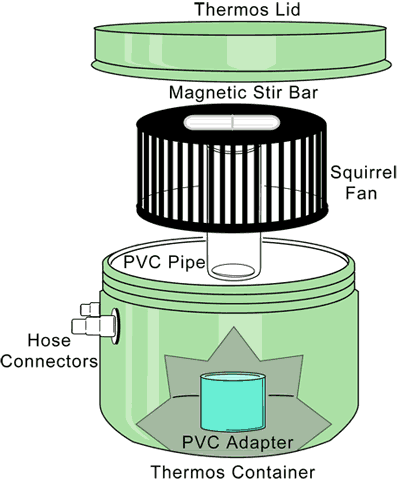Microscale glassware has become commonplace in the organic chemistry laboratory and has a number of benefits. One specific advantage of microscale glassware is its lower cost compared to macroscale glassware. Interestingly, stirring motors for both microscale and macroscale are relatively expensive, and smaller stirring motors, which are a more appropriate, size for use with microscale glassware, are not correspondingly less expensive.

The stirring device described here can be made simply for less than ten dollars and it is the appropriate size for carrying out microscale experiments. It consists of items that are readily available and can be assembled in less than a half an hour. It can be used in any laboratory in which compressed air is available. A similar device, sold by Thomas Scientific (catalog number 8612-B60), sells for $72.22.
There are two basic parts to the device (see figure). The inner part consists of a squirrel fan (available at electronic supply stores), a stirring magnet, and a piece of PVC pipe. The three are held together, as shown, using silicone adhesive. The outer part consists of two hose adapters, a PVC-adapter, and a Thermos Insulated Snack Jar (Model #1155, available in discount stores in the kitchen area). Two holes are drilled into the Thermos container, and the hose adapters are secured in the holes with silicone adhesive. Finally, the PVC, adapter is placed in the bottom of the Thermos container and fastened with adhesive.
The squirrel fan assembly—specifically, the piece of PVC pipe—is then placed inside the PVC adapter and the lid for the Thermos container is shut. Hooking the inlet hose adapter to a source of compressed air then allows the device to be used as a stirring "motor".